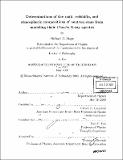Determinations of the radii, redshifts, and atmospheric compositions of neutron stars from modeling their Chandra X-ray spectra
Author(s)
Stage, Michael D. (Michael Donald), 1975-
DownloadFull printable version (11.78Mb)
Other Contributors
Massachusetts Institute of Technology. Dept. of Physics.
Advisor
Claude R. Canizares and Paul C. Joss.
Terms of use
Metadata
Show full item recordAbstract
Fitting the X-ray spectra of thermal radiation from neutron stars with realistic atmosphere models provides a way to place constraints on their radii, surface gravities and compositions, and to test general relativity in the strong field limit. Such determinations allow us to constrain the the equation of state of nuclear matter. I present fits which constrain the radii and surface compositions of two neutron stars, using high quality Chandra X-ray Observatory observations of the point source in the Cassiopeia A supernova remnant (Cas A XPS), and the isolated neutron star RX J1856.5-3754. I apply models calculated with advanced versions of the ATM model atmosphere code developed by Madej and Joss for neutron-star atmospheres composed of hydrogen, hydrogen-helium, iron, or a silicon to iron mixture. The results, taken assuming a typical value of 1.4 solar masses, show that the X-ray emission is generated from hot spot regions of scale size - 3-4 km, on stars of intrinsic radius 9 and 12.5 km. This implies a relatively stiff equation of state. For the Cas A XPS, I fit the most source photons to date with spectra extracted from three Chandra Advanced CCD Imaging Spectrometer observations (ObsIds 114, 1952, 1046), with a total effective exposure of approximately 110,000 seconds. With these data, I am able to show that atmosphere models fit significantly better than blackbody models, although a wide range of radii are permitted. I also present evidence of an absorption feature in the XPS spectrum caused by silicon present in the supernova remnant, and discuss efforts to to fit CCD pileup of the spectrum. For the RX J1856.5-3754, I fit a 450,000 second Chandra Low Energy Transmission Grating/High Resolution Camera observation. (cont.) My findings agree with previous results that a blackbody model provides the best fit, and reject hydrogen and iron atmospheres. While previous attempts to fit the spectrum with rotationally-blurred iron or solar abundance atmospheres have failed, I successfully fit the spectrum to a rotationally Doppler blurred silicon-ash model, a surface composition which might exist following a supernova. The fit implies a rotational period of approximately 2 ms.
Description
Thesis (Ph. D.)--Massachusetts Institute of Technology, Dept. of Physics, 2003. Includes bibliographical references (p. 131-139).
Date issued
2003Department
Massachusetts Institute of Technology. Department of PhysicsPublisher
Massachusetts Institute of Technology
Keywords
Physics.